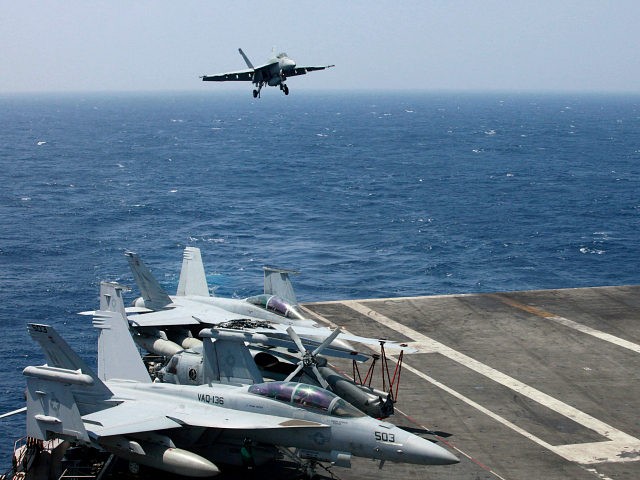This morning’s key headlines from GenerationalDynamics.com
- North Korea renews threat of massive hydrogen bomb test over Pacific
- US sends three aircraft carrier strike groups to waters around North Korea
North Korea renews threat of massive hydrogen bomb test over Pacific

Farm workers in North Korea (Michael Havis)
In an interview with CNN on Wednesday, Ri Yong-Pil, a senior diplomat in North Korea’s Foreign Ministry said that previous threats of a large hydrogen bomb test over the Pacific should be taken seriously.
The original threat came from North Korea’s foreign minister Ri Yong-ho in September, who said that North Korea was planning to test “an unprecedented scale hydrogen bomb,” just before giving a speech to the United Nations:
It could be the most powerful detonation of an H-bomb in the Pacific. We have no idea about what actions could be taken as it will be ordered by leader Kim Jong-un.
At the time, President Donald Trump tweeted a response: “Kim Jong Un of North Korea, who is obviously a madman who doesn’t mind starving or killing his people, will be tested like never before!”
So on Wednesday, Ri Yong-Pil renewed the threat:
The foreign minister is very well aware of the intentions of our supreme leader, so I think you should take his words literally.
Up until now, North Korea’s nuclear tests have taken place underground on North Korean soil. A hydrogen bomb test over the Pacific would be an enormous escalation. The hydrogen explosion would threaten shipping and planes flying overhead and would release a great deal of radiation and cause environmental damage.
The North Korean threat has been particularly alarming to the Japanese people since the missile carrying the hydrogen bomb would have to fly over Japanese airspace. The Japanese are obviously concerned that a failure in the propulsion system could bring the missile down on a Japanese city.
It is quite likely that this threat was a factor in the landslide victory of Shinzo Abe’s party in last week’s parliamentary elections. The prime minister, leader of Japan’s Liberal Democratic Party (LDP), took a highly nationalistic stance against North Korea during the campaign, and said:
We can no longer let ourselves be fooled by North Korea. We cannot succumb to its threats. By taking advantage of our strong diplomacy, we have to make sure the North will have no other option but change its policy and return to the negotiating table.
Now with Wednesday’s renewed threat by Ri Yong-Pil, nationalism is likely to surge even higher. Abe has vowed to change Japan’s constitution, and bring an end to Japan’s pacifism, and North Korea’s renewed threat should make that easier. Guardian (London, 22-Sep) and CNN and Reuters and Daily Star (London)
Related Articles
- North Korea crisis: Would the United States sacrifice Los Angeles for Seoul? (18-Oct-2017)
- Big election win for Japan’s Shinzo Abe may mean end of pacifism (23-Oct-2017)
- Japan will shoot down N. Korean missiles via ‘collective self-defense’ (13-Aug-2017)
- North Korean missile strikes sea close to Japan, threatening radar base (04-Aug-2016)
US sends three aircraft carrier strike groups to waters around North Korea
The Pentagon on Tuesday announced that the USS Theodore Roosevelt aircraft carrier and strike group would enter the US 7th Fleet area of operations in the western Pacific. The flagship will be joined by several guided-missile cruisers and destroyers.
It joins the Ronald Reagan Carrier Strike Group already in the region, where it has been taking part in joint exercises with the South Korean navy. The Ronald Reagan is permanently stationed with the 7th Fleet.
According to commanding officer Capt. Carlos Sardiello:
USS Theodore Roosevelt is prepared to carry out the full spectrum of possible missions, from humanitarian relief to combat operations. When a carrier leaves on deployment, we have to be ready for anything.
Then on Wednesday, the Pentagon announced that USS Nimitz aircraft carrier and strike group would also enter the US 7th Fleet area of operations in the western Pacific.
The Nimitz had previously been deployed with the 5th Fleet in the Mideast in Operation Inherent Resolve, the name of the U.S. military operation against the so-called Islamic State (IS or ISIS or ISIL or Daesh) in Iraq and Syria. Eventually, the Theodore Roosevelt is expected to take the place of the Nimitz in the 5th Fleet area of operations, covering the Middle East.
Having three aircraft carrier strike groups in the region is extremely rare, and represents a huge show of force in response to North Korean threats, in advance of President Trump’s scheduled visit to Seoul and Beijing next month.
However, Pentagon officials claim that the deployment of three Navy aircraft carrier groups has been planned for some time. According to spokesman Dana White:
This was a unique opportunity to show that the U.S. is the only power in the world that can demonstrate that kind of presence and a unique opportunity for them to be together.
It’s not directed towards any particular threat. But it is a demonstration that we can do something that no one else in the world can.
This is the first time since 2007 that three carrier groups have deployed together to the same location. Navy.mil and Military.com and The Hill and Navy.mil and Russia Today
Related Articles
- Trump’s North Korea sanctions stop short of military blockade (22-Sep-2017)
- North Korea and Russia continue to incite a new Korean War (06-Sep-2017)
- America’s UN ambassador Nikki Haley says North Korea is ‘begging for war’ (05-Sep-2017)
- Tensions grow on Korean peninsula over THAAD and N. Norea-Malaysia relations (08-Mar-2017)
KEYS: Generational Dynamics, North Korea, Ri Yong-Pil, Ri Yong-ho, Japan, Shinzo Abe, Liberal Democratic Party, LDP, Theodore Roosevelt, Ronald Reagan, Carlos Sardiello, Nimitz, Dana White, 7th Fleet, 5th Fleet, Operation Inherent Resolve, Islamic State / of Iraq and Syria/Sham/the Levant, IS, ISIS, ISIL, Daesh
Permanent web link to this article
Receive daily World View columns by e-mail

COMMENTS
Please let us know if you're having issues with commenting.